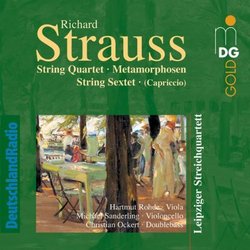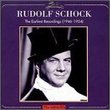| All Artists: Richard Strauss, Leipzig String Quartet Title: Strauss: Chamber Music Members Wishing: 0 Total Copies: 0 Label: MD&G Records Original Release Date: 1/1/2003 Re-Release Date: 2/25/2003 Genre: Classical Styles: Chamber Music, Historical Periods, Classical (c.1770-1830) Number of Discs: 1 SwapaCD Credits: 1 UPCs: 760623114224, 760623114224 |
Search - Richard Strauss, Leipzig String Quartet :: Strauss: Chamber Music
CD DetailsSimilar CDs
|
CD ReviewsSumptuous Strauss Strings = Another Leipziger Winner... Sébastien Melmoth | Hôtel d'Alsace, PARIS | 06/15/2009 (5 out of 5 stars) "Sumptuous Strauss Strings = Another Leipziger Winner...
. The String Sextet with which Strauss begins his ultimate opera Capriccio is a brilliant metafictive stroke whereupon the opera's plot turns on a discussion of melos vs. logos. The Sextet starts out in a rich, sweet, and mellow mode; then it breaks out in a quasi-Brahmsian gypsyish episode followed by echt-late-Straussian chromatic-melodic note spinning--betimes sounding a bit like his fellow Bavarian, Reger, at his most lyrical. Finally it returns to the opening sickly-sweet melodiousness wherein variations on the original theme are masterfully permuted. The Sextet ends in a lovely flourish. The very youthful String Quartet was completed in 1881 when Strauss was sixteen years of age. It shows good command of form, characteristic quartet expression, and nice vocalization: certainly worth knowing for aficionados of the genre. The Quartet is scored with slightly more gravitas, but otherwise Movement I explores a very Mozartean thematic ambience with Brahmsian transitional passages and further Brahms-inflected turns of phrase. It concludes with a sense of ebullient affirmation. The effervescent and skittish Scherzo features humorous bagpipe-droning effects; the interesting Trio displays piquant pizzicati in a minor-key mode. III. Andante cantabile, molto espressivo is very pathétique with Wagnerian smeared chords and a lambent duo between violin and cello in a very affective twilight. IV. A pleasing enough, but somewhat banal Finale is in a faux-Brahmsian manner. It is a little-known fact that Strauss originally scored the Metamorphosen for eleven strings; then reduced the number of parts to seven; finally settling on the obscure number of twenty-three solo instruments. Here we have a rare reading of the version for String Septet!--(a conventional string sextet plus double bass). And very nice it is too: to have this up-close and intimate version wherewith one is much "closer" to the music. But what is the "meaning" of the Metamorphosen? Well, certainly it reflects a civilizational "cut" (in the postmodern sense) even more severe and definitive than the cut effected by the First World War; for by 1945, the devastation (nay, holocaust) of European (and far East Asian) civilization was de facto. With the Metamorphosen Strauss bids the ultimate farewell to the culture of Beethoven, Goethe, and Wagner; and via a synthesis, he irrevocably makes a turn towards the "new" Post-Modernism which was then birthed. (We know now, of course, that Postmodernism is merely a continuation of (Western) cultural evolution in the train of Mediaevalism~Renaissance~Enlightenment~Romanticism~Modernism... [And by the way, a perceptive critic could hold forth that by the 1990s the World was moving into--and COULD HAVE moved into--an elegant, gracious, and beneficent POST-Postmodernism; but unfortunately for Earth, a certain clique of vicious men hijacked humankind into a degenerate and disgusting Neo-Primitivism and the New Great Depression... ...thanks fellas, way to go!]) The Leipziger String Quartet is superb! . Brahms: Clarinet Quintet, Op.115, String Quartet, Op.51,2 Schubert: Complete String Quartets, Vol. 1 . Richard Strauss: Sonatinen Nos. 1 & 2 Richard Strauss: Ophelia-Lieder, Op. 67; Enoch Arden, Op. 38; Piano Sonata, Op. 5; 5 Piano Pieces, Op. 3 Strauss: Metamorphosen; Capriccio; Piano Quartet Bruckner: String Quintet; Intermezzo; Strauss: Prelude to Capriccio Strauss: Lieder . Capriccio Richard Strauss - Capriccio / Schwarzkopf, Wächter, Gedda, Fischer-Dieskau, Hotter, Ludwig, Moffo, Philharmonia Orchestra, Sawallisch Strauss - Capriccio / Kiri Te Kanawa, Hagegard, Heilmann, Bär, von Halem, Fassbaender, Hollweg, Hotter, Wiener Phil., Ulf Schrimer ." |





